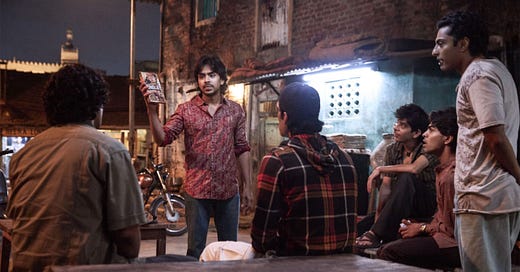‘Arrey, shauk paal ke kya karega, Malegaon mein tu marega!’
I’ve rewatched Superboys of Malegaon for many reasons — its larger than life portrayal of small-town characters, storytelling at its finest that roots for the underdogs, but also the fact that it is carried on the shoulders of Muslim characters and none of them are accessories to the plot. It is a movie around small-town cinema industry that squarely runs of the shoulders of Nasir Shaikh (played by Adarsh Gourav), his friends and the predominantly Muslim community he is part of.
This kind of self-affirming portrayal took me back to my maternal grandmother’s town, Moradabad. Over many visits in the 1990s until early to mid-2000s, Moradabad was a place where I felt a sense of unapologetic self-hood in one’s identity and belonging.
The moment we’d arrive at the railway station, coolies would huddle around to carry our luggage, and later the rickshaw pullers would expertly serpentine through narrow streets avoiding potholes. Most shops with their wooden doors and age-old latches were perched higher up from the streets, brass warehouses and artisans hammered onto the metals, was a common sight. With rickshaws, hole in the wall barber shops, and hair oil advertisements painted on walls, the movie does an incredible job of depicting small-town India in the 90s.
Greetings such as ‘Salamwalaikum’, ‘Khudahafiz’ are part and parcel of one’s life, and “naan-nihari ka intezaam karna padta hai” is a local catch-phrase but universally understandable. Then there was the Moradabadi dialect, with sentences ending with “aa riya” “ja riya”, which viewers of Superboys of Malegaon would associate with.
My grandmother’s house was right opposite a mosque, which meant that azaan was a time-keeper. Lunch was served after zohar and around maghrib, all play and games were suspended. Owing to multiple mosques we would start bargaining with elders to resume play right after one azaan was done (we rarely won that argument). In Superboys of Malegaon, mosques dotting the landscape and men wearing skull caps selling their wares, watching movies, all exist without fitting into a stereotype.
The movie also showcases that while in such towns public spaces are largely run and occupied by men, women (Muslim or otherwise) find ways to push boundaries, bend rules and challenge norms. In the movie, an academically brilliant woman gets to finish her studies but not marry of her choice, another chooses a life of performance and acting leaving an abusive marriage, while another becomes a lawyer and subsequently a movie producer. I have many stories of my mother’s fierce ways of ascertaining her selfhood while she was growing up in Moradabad — challenging an existing social order in her own manner.
Superboys of Malegaon depicts how hyperlocal Indian Muslimness is — how it is shaped not just by a religion and its set of beliefs, but also the economy, politics, social norms, history, language, food and many other things.
“Arrey zindagi mein thodi comedy, thoda hasna zaruri hai na!”
Both cities also carry vestiges of communal violence. My mother and other relatives have recounted how the 1980s’ riots led to months-long curfew, rationing of groceries, and postponement of Board exams. But alongside such stories are also tales of my mother secretly sourcing cigarettes for her brothers, children jumping over roof-tops to catch up with friends and cousins, and my Nani improvising recipes with the bare minimum ingredients.
While Superboys of Malegaon does not delve into the town’s communal history, it underscores how vulnerable the marginalised are, through a scene in which cops vandalise Nasir’s video parlour. It is in that state of anger and helplessness that he decides to make a movie, the repression channels his creativity. He finds ways to nurture his big dreams and draws support from his community. There’s ingenuity and talent in directing a pan shot on a bullock cart, re-writing and localising cult classics, creating celebrities out of local faces — underscoring a refusal of the underdog to be defined by those in power.
“Bambai nahi ja saktey, bambai ko idhar laana padega”
Malegaon is a cosmos of its own, its film industry a product of centring oneself in your universe. The movie is an ode to asserting one’s dignity through art and cinema, without institutional support or even validation. It shows that what truly matters is being celebrated by those closest to us, whether our families or Malegaon ki public!
In making films only for the Malegaon audience, Nasir and his team broke a spell of escapism that locals thronged cinemas for, creating a utopia where it was possible to pursue dreams often reserved for a few and actualised by even fewer. Its film industry exists for itself. Not Mumbai. Not Bollywood.
Superboys of Malegaon brings Muslim stories to centre-stage, stories that have rarely made it to the big screen. These characters are the heroes of their film making it big without a saviour or godfather. They own their flaws, their mistakes, their tragedies and their glories.
You empathise and root for all of them. They become part of your story too. You laugh with the characters, you want to watch Malegaon Ki Sholay, and celebrate their wins. Superboys of Malegaon is a reminder that we must first make our stories matter to ourselves, believe in them, and in that lies the possibility of transformation.
Mariyam Haider is a writer-researcher, spoken word artist and producer & host of Main Bhi Muslim podcast.




Ohh Mariyam, the vivid descriptions of Moradabad reminds me of my own home towns - Hazaribag and Ranchi. Loved the film for its authentic portrayal of real lives and have been recommending it to everyone
So well written ! I saw this movie and loved it for all the reasons you so beautifully put across .